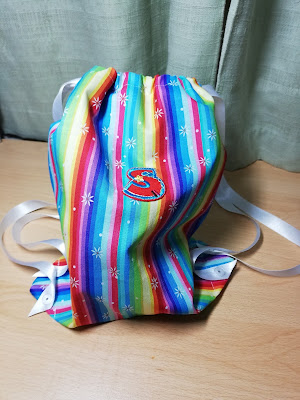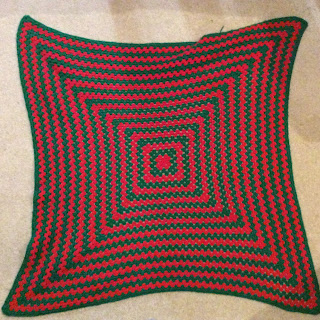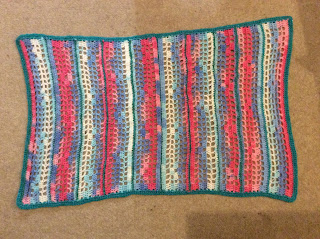I then got a bit carried away with myself and decided to make some for her little friends, too, so the pictures in this will have a few different fabrics but the bags are all made the same way. You could probably make one in an evening or two, it took me less than a week to make three (and some days I only have an hour to do sewing).
I based my design on this tutorial by Kristin Omdahl, but I’ve adapted it so I thought I’d do a proper tutorial for this version.
Materials list - for a toddler sized backpack
Fabric - depending on the pattern of the fabric, you might need more but you should be able to make one bag out of a fat quarter, or two bags out of half a metre of fabric.
Cotton thread - to sew it together with
Cord or ribbon - for the drawstrings. For toddler sized straps, you’ll need two metres length. For it to be comfortable on an adult, you’ll need 2.5 to 3 metres.
Something to attach the strings to the corners of the bag - I used Kam snaps so that I can easily detach and replace the strings if they get broken or are the wrong length, but you could also make a reinforced hole in the corner of the bag (using a metal ring or something similar) and thread the strings through that.
Other useful items - sewing machine (as it’s all straight stitch you could sew it by hand but it would take a lot longer), iron, needle to sew in the ends, pins, scissors, bodkin or safety pin to thread the string through the channel. If you’re using Kam snaps as an attachment, you’ll need a press to attach them with also. Most suppliers of the snaps will sell the presses too.
How big a piece of fabric do I need?
1. Decide how big a bag you want. Length (x), height (y) and width of the bottom (w).
2. How much seam allowance (a) do you want? (I used half inch seams, partly because it made the numbers easy to work out, partly because that was in the tutorial I was following)
3. How wide a channel (c) do you want for your strings? (As I am using ribbon, my channels ended up about an inch wide).
4. Are you using one piece of fabric folded at the base, or two pieces sewn together? (If you’re using one piece, double the length and take off 2a)
5. Maths time! (See my sketch)
a) Two pieces of fabric: x + 2a by y + 2a + 2c + 0.5w
For a bag 10” long by 10” high with a bottom width of 3”, I used two pieces of fabric 11” by 15”. As it’s a bag, the size can vary to suit how big your fabric is - i had a piece of fabric that was 40” wide so I cut the pieces 10” wide for that so that I could make two bags from the one piece of fabric.
b) One piece of fabric: x + 2a by 2(y + 2c + a + 0.5w)
For a 10” long by 10” high bag, I would use one piece of fabric 11” by 28”. This only works if you have a fabric pattern that doesn’t matter if it’s upside down, though!
These instructions will be for making the bag out of two pieces of fabric, but the tutorial I linked above uses only one piece so refer to that if my instructions are confusing you.
Step One: Iron your fabric!
It might seem like a waste of time but it is essential if you want to measure the fabric properly and have it turn out looking good.
Step two: Measure fabric, mark out, check it! Cut it.
Especially check that you have marked out a rectangle with square corners and not drawn one of the edges slightly wonky.
Step Three: Press and sew the hems
Fold over half an inch of fabric on each side and press it with an iron (if you get a good enough crease with the iron, the fold will stay and you won’t need to pin it). Sew the hems a quarter of an inch in from the fold (if you have fabric that’s likely to fray a lot, you might need to do a double fold so that the raw edge is turned under when you sew it.)
Step Four: Channel for the drawstring
Check how big of a channel you want and fold down the top edge of each piece of fabric so that it will be wide enough for the string to run through easily. You will have two strings so make sure you allow for them both if you’re using thick cording as a string. Stitch along the line you sewed for the hem so that the channel stays the same size all the way along.
Step Five (optional): decorate your fabric
If you have anything to decorate the bag with (I added a letter motif for the child’s initial), now is the best time to add it as you can judge the position on the finished bag. Remember that the final bag will be an inch or so shorter than the fabric you have now as we haven’t allowed for the base yet.
Step Five: Pin together and make up
If you’ve been careful with your measuring and consistent with your hems etc, you should now have two rectangular pieces of fabric the same size as each other. I was slightly lazy with my hemming accuracy so the two pieces were not quite matching. Either way, the critical bit is that the two channels line up with each other - any excess at the base of the fabric will just go into the seam inside the bag and nobody will ever know except you!
Press the fabric again so it looks neat, then pin the two pieces right sides together, making sure that the two channels line up. Stitch along the hem lines of the two sides and bottom (if your fabric isn’t perfectly aligned, put the smaller piece on top so you can check that you are catching the edge in you stitching). Stop just by the top hem that is now forming the channel so that you don’t sew up the channel or the top of the bag.
Turn it the right way out. You now have a decent looking bag! You will need to use something like a pencil to make sure the corners are turned out as well as you can get them - the two hems meeting make the corner a little too bulky to turn out all the way.
Step Six: The base
Fold the bottom corner flat so that it’s like a triangle. (See picture). Measure across the width that you want your bag to be, mark and pin along that line. Stitch along the line - you will now have your bag with two little flaps at each corner, that you can attach the strings to.
And there you have it! A lovely bag!
Note: A closed loop like the drawstrings can be a strangulation risk for babies and small children. That’s one reason why I used the snaps and attached the strings separately - in the hope that the snaps would form a weak point in the event of getting caught around the neck or arm. HOWEVER snaps like the ones I use are not actually designed for that purpose, so you should never leave a baby or child unsupervised with it just in case.








































